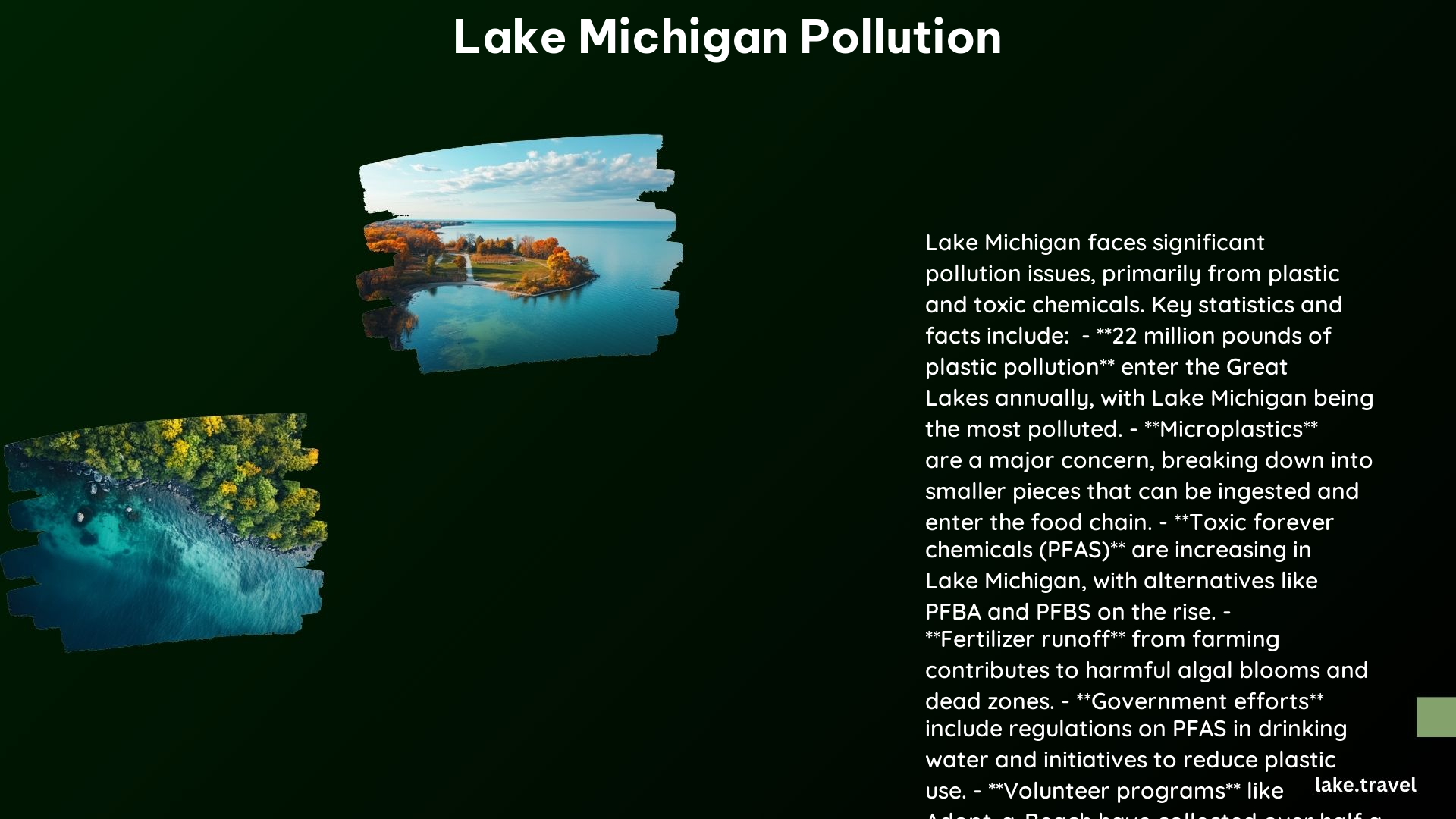Lake Michigan, the second-largest of the Great Lakes, is facing a growing pollution crisis that threatens its delicate ecosystem and the health of millions who rely on it for drinking water. From toxic “forever chemicals” to plastic waste and fertilizer runoff, the lake’s waters are under siege, and the consequences are far-reaching.
The Current Health Status of Lake Michigan

Toxic “Forever Chemicals”
Lake Michigan is contaminated with per- and polyfluoroalkyl substances (PFAS), also known as “forever chemicals.” These highly persistent compounds have been linked to various health issues, including cancer, and can take years to leave the human body.
Plastic Pollution
The Great Lakes, including Lake Michigan, are the most polluted by plastic in the world. Over 22 million pounds of plastic pollution enter these waterways annually, with Lake Michigan being the most affected. This includes microplastics that can be ingested by aquatic life and eventually make their way into the human food chain.
Fertilizer Runoff
Excessive use of fertilizers in agriculture has led to harmful algal blooms in Lake Michigan, creating dead zones and making the water undrinkable. This runoff is a significant contributor to the lake’s declining water quality.
Main Pollutants Affecting Lake Michigan’s Health

PFAS Contamination
PFAS are found in a wide range of products, from rainwater to sewage treatment plant discharges and industrial emissions. These chemicals are highly resistant to degradation and can accumulate in human blood, posing serious health risks.
| Pollutant | Source |
|---|---|
| PFAS | Rainwater, sewage treatment plant discharges, industrial emissions |
| Plastics | Single-use items, microbeads, other sources |
| Fertilizers | Runoff from agricultural practices |
Plastic Pollution
Plastic pollution in Lake Michigan comes from a variety of sources, including single-use items, microbeads, and other sources. These plastics can break down into microplastics, which can be ingested by aquatic life and eventually make their way into the human food chain.
Fertilizer Runoff
Excessive use of fertilizers in agriculture has led to harmful algal blooms in Lake Michigan, creating dead zones and making the water undrinkable. This runoff is a significant contributor to the lake’s declining water quality.
Impact of PFAS Contamination
Human Health Risks
PFAS have been linked to various health issues, including cancer, and can accumulate in human blood, taking years to leave the body. This poses a significant threat to the 40 million people who rely on the Great Lakes, including Lake Michigan, for drinking water.
Ecosystem Disruption
PFAS can disrupt the food chain and ecosystem balance, as they are ingested by aquatic life and can bioaccumulate, affecting the overall health of the lake’s ecosystem.
Drinking Water Contamination
PFAS have been detected in drinking water drawn from Lake Michigan, posing a risk to the health of millions of people who rely on the lake as a source of drinking water.
Efforts to Address Pollution
Government Regulations
The Biden administration has mandated testing for PFAS in drinking water, and utilities have five years to upgrade their treatment plants to filter out these compounds. This is a step in the right direction, but more needs to be done to address the broader pollution issues affecting Lake Michigan.
Community Initiatives
Organizations like the Alliance for the Great Lakes are working to reduce plastic pollution through Adopt-a-Beach cleanups and advocating for legislation to phase out microbeads. These community-driven efforts are crucial in raising awareness and driving change.
Corporate Actions
Some companies, such as McDonald’s and Mondelez, are taking steps to reduce plastic packaging and increase recycling, which can help mitigate the plastic pollution problem in Lake Michigan.
Reference:
– https://phys.org/news/2024-06-toxic-chemicals-lake-michigan-great.html
– https://greatlakes.org/great-lakes-plastic-pollution-fighting-for-plastic-free-water/
– https://michiganintheworld.history.lsa.umich.edu/environmentalism/exhibits/show/main_exhibit/pollution_politics/great-lakes-pollution
– https://voices.uchicago.edu/findingchicago/2021/09/11/chemicals-damaging-lake-michigan/comment-page-1/
– https://www.epa.gov/greatlakes/lake-michigan
